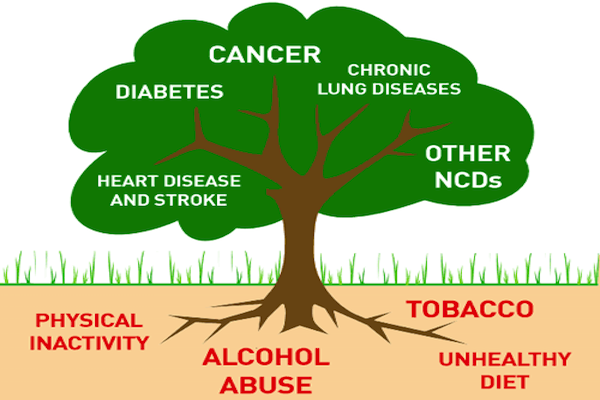The burden of non-communicable diseases in relation to economic status of countries
DOI:
https://doi.org/10.15419/bmrat.v5i1.411Keywords:
Age-standardized mortality, Human development index, Non-communicable diseases, Premature mortalityAbstract
Background: The aim of this study was to investigate the correlation between mortality from non-communicable diseases (NCDs) and national human development index (HDI) of a country, as well as investigate the correlation between premature mortality from NCDs and national HDI.
Method: Data for age-standardized mortality rate (ASRM) of NCDs and premature mortality (before age 70 years) in percentage for total NCDs in 2015 were obtained from the World Health Organization (WHO) databases. National HDI data for the year 2015 were obtained from the 2015 Human Development Report. Linear regression model was used for assessment of correlation between HDI and mortality. One-way ANOVA was used to test the difference in mean mortality of various HDI group countries; P ≤ 0.05 was considered significant.
Results: The results suggested an inverse correlation between HDI and ASRM for both men and women. The negative relation was also reported for percentage premature mortality and HDI. Tukey post hoc test (p < 0.001) indicated that countries with very high HDI have low ASRM and premature mortality (compared to those with high HDI and so on). The greatest mortality was observed in low HDI countries.
Conclusion: Management of non-communicable diseases is one of the greatest challenges for low and middle HDI countries. In order to control the disease burden, governments should pay serious attention to their economic development.
References
Beaglehole, R., Bonita, R., Horton, R., Adams, C., Alleyne, G., Asaria, P., . . . Watt, J., & the Lancet NCD Action Group, & the NCD Alliance. (2011). Priority actions for the non-communicable disease crisis. Lancet, 377(9775), 1438–1447. https://doi.org/10.1016/S0140-6736(11)60393-0 PMID:21474174
Bray, F., Jemal, A., Grey, N., Ferlay, J., & Forman, D. (2012). Global cancer transitions according to the Human Development Index (2008-2030): A population-based study. The Lancet. Oncology, 13(8), 790–801. https://doi.org/10.1016/S1470-2045(12)70211-5 PMID:22658655
Ferrari, A. J., Charlson, F. J., Norman, R. E., Patten, S. B., Freedman, G., Murray, C. J., . . . Whiteford, H. A. (2013). Burden of depressive disorders by country, sex, age, and year: Findings from the global burden of disease study 2010. PLoS Medicine, 10(11), e1001547. https://doi.org/10.1371/journal.pmed.1001547 PMID:24223526
Global status report on noncommunicable diseases 2011. Geneva: World Health Organization, (http://www.who.int/nmh/publications/ncd_report2010/en)
Hancock, C., Kingo, L., & Raynaud, O. (2011). The private sector, international development and NCDs. Globalization and Health, 7(1), 23. https://doi.org/10.1186/1744-8603-7-23 PMID:21798001
Jahan, S., Jespersen, E., Mukherjee, S., Kovacevic, M., Bonini, A., Calderon, C., & Lucic, S. (2015). Human development report 2015: Work for human development. New York, NY, USA: UNDP.
Lozano, R., Naghavi, M., Foreman, K., Lim, S., Shibuya, K., Aboyans, V., . . . Memish, Z. A. (2012). Global and regional mortality from 235 causes of death for 20 age groups in 1990 and 2010: A systematic analysis for the Global Burden of Disease Study 2010. Lancet, 380(9859), 2095–2128. https://doi.org/10.1016/S0140-6736(12)61728-0 PMID:23245604
Moran, A. E., Forouzanfar, M. H., Roth, G., Mensah, G., Ezzati, M., Murray, C. J., & Naghavi, M. (2014). Temporal trends in ischemic heart disease mortality in 21 world regions, 1980-2010: The Global Burden of Disease 2010 Study. Circulation, CIRCULATIONAHA-113.
Noncommunicable diseases. Geneva: World Health Organization, 2013 (http://www.who.int/mediacentre/factsheets/fs355/en/
Pervaiz, R., & Faisal, F. (2017). Cancer incidence and mortality are associated with human development index and health setups in Africa. Journal of the Egyptian National Cancer Institute, 29(3), 123–126. https://doi.org/10.1016/j.jnci.2017.05.003 PMID:28669451
Pervaiz, R., Tulay, P., Faisal, F., & Serakinci, N. (2017). Incidence of cancer in the Turkish Republic of Northern Cyprus. Turkish Journal of Medical Sciences, 47(2), 523–530. https://doi.org/10.3906/sag-1510-145 PMID:28425241
World Health Organization, 2015. Non-communicable diseases, http://www.who.int/gho/ncd/mortality_morbidity/ncd_total/en/. Accessed on 25th may 2017.
World Health Organization, 2015. Non-communicable diseases, http://www.who.int/gho/ncd/mortality_morbidity/ncd_premature/en/. Accessed on 25th may 2017.
World Health Organization. (2011). Cause-specific mortality, 2008: WHO region by country. Geneva: WHO.
World Health Organization, 2013. Global action plan for the prevention and control of non-communicable diseases 2013-2020.

Downloads
Published
Issue
Section
License
Copyright The Author(s) 2017. This article is published with open access by BioMedPress. This article is distributed under the terms of the Creative Commons Attribution License (CC-BY 4.0) which permits any use, distribution, and reproduction in any medium, provided the original author(s) and the source are credited.
